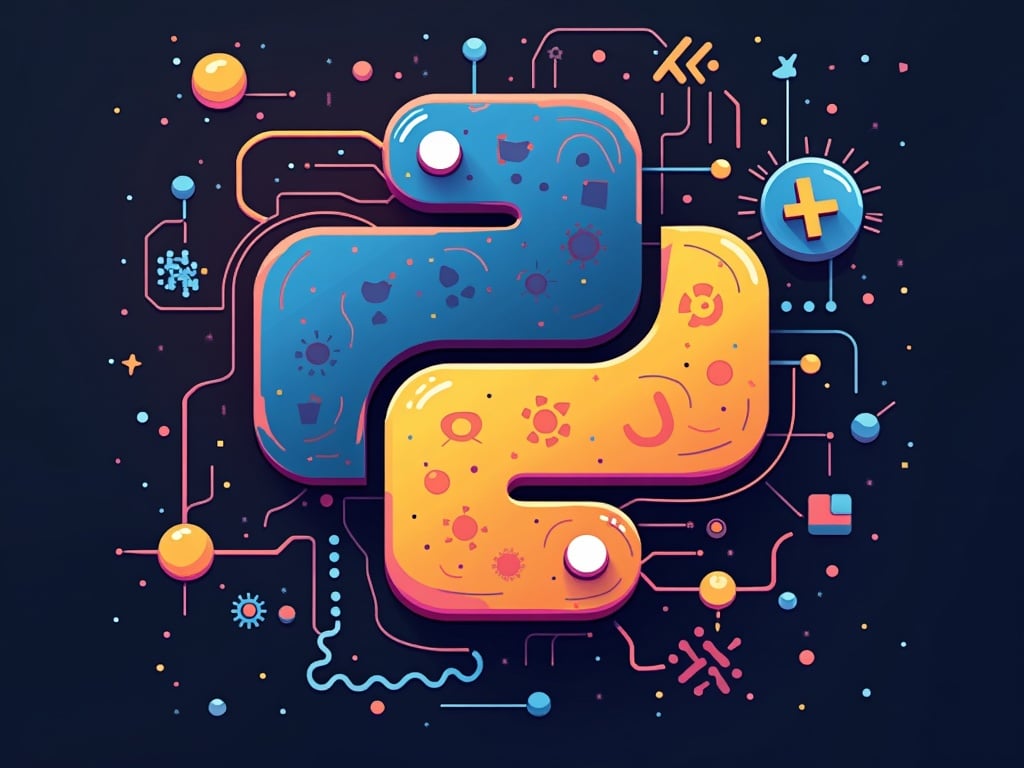Create Your Own Snake Game in Python: A Step-by-Step Guide
Imagine the thrill of recreating a classic – the legendary Snake game! This guide will walk you through building your very own version using Python, turning what might seem like a complex project into a manageable and incredibly rewarding experience. Prepare to delve into the world of game development, learn new Python skills, and unleash your inner coding creativity.
Why Build a Snake Game in Python?
Building a Snake game is more than just a fun project; it’s an excellent way to solidify your understanding of fundamental Python concepts. You’ll be working with:
- Object-oriented programming (OOP): Defining the snake and food as objects with specific attributes and behaviors.
- Game loops: Creating the continuous cycle that drives the game.
- Event handling: Responding to user input (key presses) to control the snake.
- Collision detection: Determining when the snake collides with itself or the game boundaries.
- Basic graphics: Displaying the game elements on the screen using libraries like Pygame or Tkinter.
This project provides a practical application of these concepts, making them easier to grasp and remember. Plus, you get a cool game to show off to your friends! It’s a fantastic project for beginners and a great way to brush up on your skills if you’re more experienced.
Setting Up Your Development Environment
Before we dive into the code, let’s set up our environment. You’ll need Python installed on your system. If you don’t have it already, download the latest version from the official Python website.
Choosing a Graphics Library: Pygame vs. Tkinter
For displaying the game, we need a graphics library. Two popular choices are Pygame and Tkinter.
- Pygame: A powerful library specifically designed for game development. It offers excellent performance and a wide range of features for handling graphics, sound, and input.
- Tkinter: Python’s built-in GUI library. It’s simpler to use than Pygame, making it a good option for beginners or if you prefer a more lightweight approach.
In this guide, we’ll use Pygame due to its game-focused features. To install Pygame, open your terminal or command prompt and run:
bash
pip install pygame
Breaking Down the Snake Game: Core Components
Our Snake game will consist of the following essential components:
- The Snake: A segmented entity that moves around the screen, consuming food and growing in length.
- The Food: An item that appears randomly on the screen, providing sustenance for the snake.
- The Game Board: The boundaries within which the game takes place.
- Game Logic: The rules that govern the game, including movement, collision detection, and scoring.
We’ll define these components as classes in Python, adhering to the principles of object-oriented programming.
Coding the Snake Game: Step-by-Step
Let’s start building our game! We’ll break it down into smaller, manageable steps.
1. Initializing Pygame and Setting Up the Game Window
First, we need to initialize Pygame and create the game window.
python
import pygame
import random
pygame.init()
# Define screen dimensions
screen_width = 600
screen_height = 480
screen = pygame.display.set_mode((screen_width, screen_height))
pygame.display.set_caption(Snake Game)
# Define colors
black = (0, 0, 0)
white = (255, 255, 255)
red = (255, 0, 0)
green = (0, 255, 0)
# Clock to control the game speed
clock = pygame.time.Clock()
This code imports the necessary libraries (pygame and random), initializes Pygame, sets the screen dimensions and caption, defines some colors, and creates a clock object to control the game’s frame rate.
2. Creating the Snake Class
Now, let’s define the Snake class. This class will represent the snake and its behavior.
python
class Snake:
def __init__(self):
self.body = [(100, 50), (90, 50), (80, 50)] # Initial snake body
self.direction = RIGHT
def move(self):
x, y = self.body[0]
if self.direction == RIGHT:
new_head = (x + 10, y)
elif self.direction == LEFT:
new_head = (x – 10, y)
elif self.direction == UP:
new_head = (x, y – 10)
elif self.direction == DOWN:
new_head = (x, y + 10)
self.body.insert(0, new_head)
self.body.pop() # Remove the last segment
def draw(self, screen):
for segment in self.body:
pygame.draw.rect(screen, green, (segment[0], segment[1], 10, 10))
The `Snake` class has an `__init__` method to initialize the snake’s body and direction. The `move` method updates the snake’s position based on its current direction. The `draw` method draws the snake on the screen.
3. Creating the Food Class
Next, we’ll create the Food class. This class will represent the food that the snake eats.
python
class Food:
def __init__(self, screen_width, screen_height):
self.x = round(random.randrange(0, screen_width – 10) / 10.0) 10.0
self.y = round(random.randrange(0, screen_height – 10) / 10.0) 10.0
def draw(self, screen):
pygame.draw.rect(screen, red, (self.x, self.y, 10, 10))
The `Food` class has an `__init__` method to randomly generate the food’s position on the screen. The `draw` method draws the food on the screen.
4. Implementing the Game Loop
The game loop is the heart of the game. It handles user input, updates the game state, and draws the game elements on the screen.
python
def game_loop():
snake = Snake()
food = Food(screen_width, screen_height)
game_over = False
while not game_over:
for event in pygame.event.get():
if event.type == pygame.QUIT:
game_over = True
if event.type == pygame.KEYDOWN:
if event.key == pygame.K_LEFT and snake.direction != RIGHT:
snake.direction = LEFT
elif event.key == pygame.K_RIGHT and snake.direction != LEFT:
snake.direction = RIGHT
elif event.key == pygame.K_UP and snake.direction != DOWN:
snake.direction = UP
elif event.key == pygame.K_DOWN and snake.direction != UP:
snake.direction = DOWN
snake.move()
# Check for collision with food
if snake.body[0][0] == food.x and snake.body[0][1] == food.y:
food = Food(screen_width, screen_height)
# Grow the snake – add a new segment to the body
snake.body.append((0,0)) #temporary value, it will be updated in the next move
# Check for collision with boundaries
if snake.body[0][0] >= screen_width or snake.body[0][0] < 0 or snake.body[0][1] >= screen_height or snake.body[0][1] < 0:
game_over = True
# Check for collision with self
if snake.body[0] in snake.body[1:]:
game_over = True
screen.fill(black)
snake.draw(screen)
food.draw(screen)
pygame.display.update()
clock.tick(15) # Control game speed - frames per second
pygame.quit()
quit()
game_loop()
The `game_loop` function creates instances of the `Snake` and `Food` classes. It then enters a loop that continues until the game is over. Inside the loop, it handles user input, updates the snake's position, checks for collisions, draws the game elements on the screen, and updates the display. The `clock.tick(15)` line controls the game's frame rate, ensuring that the game runs at a consistent speed.

Enhancements and Further Development
Now that you have a basic Snake game working, you can explore several enhancements and further development options:
Adding a Score
You can easily add a score to your game by keeping track of how many food items the snake has eaten. Display the score on the screen using Pygame’s font rendering capabilities.
Increasing Difficulty
Implement increasing difficulty by gradually increasing the snake’s speed or reducing the size of the game board as the game progresses.
Power-Ups
Introduce power-ups that the snake can collect, such as temporary speed boosts, invincibility, or the ability to pass through walls.
Sound Effects
Add sound effects for eating food, collisions, and other game events to enhance the player experience. Pygame has good sound support.
Graphical Improvements
Enhance the game’s visuals by using more sophisticated graphics, textures, and animations. You can find free game assets online.
Essential Tips for Success:
Mastering game development is a journey. Here are some tips to help:
**Start Small:Begin with the core mechanics and gradually add features.
**Test Frequently:Run your game often to catch bugs early.
**Comment Your Code: Make it easier to understand and maintain.
**Use Version Control:Tools like Git are invaluable for tracking changes.
**Explore Game Development Communities: Find resources, ask questions, and learn from other developers.
Understanding Collision Detection in Detail
Collision detection is crucial for any game, and the Snake game is no exception. Let’s delve deeper into how it works in our example:
**Food Collision:We check if the snake’s head (the first element in the `snake.body` list) has the same coordinates as the food. If they match, it means the snake has eaten the food.
**Boundary Collision:We verify if the snake’s head has gone beyond the screen boundaries (either horizontally or vertically). This signals the end of the game.
**Self-Collision: We iterate through the snake’s body segments (excluding the head) and check if the head’s coordinates match any of the body segment’s coordinates. If there’s a match, the snake has collided with itself, resulting in game over.
Optimizing collision detection is essential for performance, especially in more complex games. Efficient algorithms and data structures can help minimize the computational cost.
The Complete Code
Here’s the complete code for the Snake game:
python
import pygame
import random
pygame.init()
# Define screen dimensions
screen_width = 600
screen_height = 480
screen = pygame.display.set_mode((screen_width, screen_height))
pygame.display.set_caption(Snake Game)
# Define colors
black = (0, 0, 0)
white = (255, 255, 255)
red = (255, 0, 0)
green = (0, 255, 0)
# Clock to control the game speed
clock = pygame.time.Clock()
class Snake:
def __init__(self):
self.body = [(100, 50), (90, 50), (80, 50)] # Initial snake body
self.direction = RIGHT
def move(self):
x, y = self.body[0]
if self.direction == RIGHT:
new_head = (x + 10, y)
elif self.direction == LEFT:
new_head = (x – 10, y)
elif self.direction == UP:
new_head = (x, y – 10)
elif self.direction == DOWN:
new_head = (x, y + 10)
self.body.insert(0, new_head)
self.body.pop() # Remove the last segment
def draw(self, screen):
for segment in self.body:
pygame.draw.rect(screen, green, (segment[0], segment[1], 10, 10))
class Food:
def __init__(self, screen_width, screen_height):
self.x = round(random.randrange(0, screen_width – 10) / 10.0) 10.0
self.y = round(random.randrange(0, screen_height – 10) / 10.0) 10.0
def draw(self, screen):
pygame.draw.rect(screen, red, (self.x, self.y, 10, 10))
def game_loop():
snake = Snake()
food = Food(screen_width, screen_height)
game_over = False
while not game_over:
for event in pygame.event.get():
if event.type == pygame.QUIT:
game_over = True
if event.type == pygame.KEYDOWN:
if event.key == pygame.K_LEFT and snake.direction != RIGHT:
snake.direction = LEFT
elif event.key == pygame.K_RIGHT and snake.direction != LEFT:
snake.direction = RIGHT
elif event.key == pygame.K_UP and snake.direction != DOWN:
snake.direction = UP
elif event.key == pygame.K_DOWN and snake.direction != UP:
snake.direction = DOWN
snake.move()
# Check for collision with food
if snake.body[0][0] == food.x and snake.body[0][1] == food.y:
food = Food(screen_width, screen_height)
# Grow the snake – add a new segment to the body
snake.body.append((0,0)) #temporary value, it will be updated in the next move
# Check for collision with boundaries
if snake.body[0][0] >= screen_width or snake.body[0][0] < 0 or snake.body[0][1] >= screen_height or snake.body[0][1] < 0:
game_over = True
# Check for collision with self
if snake.body[0] in snake.body[1:]:
game_over = True
screen.fill(black)
snake.draw(screen)
food.draw(screen)
pygame.display.update()
clock.tick(15) # Control game speed - frames per second
pygame.quit()
quit()
game_loop()
Conclusion: From Zero to Snake Hero!
Congratulations! You’ve successfully built your own Snake game in Python. This project serves as a solid foundation for exploring more complex game development concepts. Don’t be afraid to experiment, modify the code, and add your own creative twists. The world of game development is vast and exciting, and this is just the beginning of your journey. Now go forth and create something amazing!
